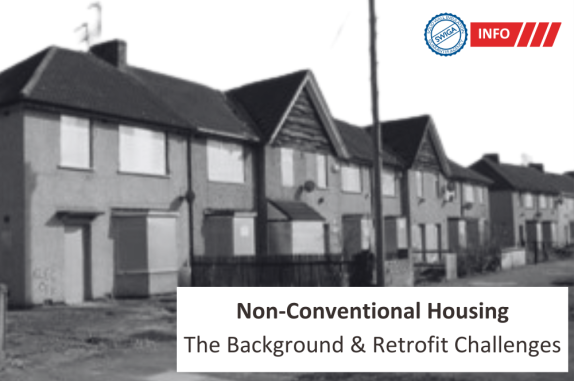SWIGA NEWS
Latest Industry News
Non-Conventional Housing - The Background & Retrofit Challenges

The History Of Non Conventional Housing
When it comes to housing in the UK it’s pretty fair to say that we’ve always been a nation of brick lovers, although the way we’ve used them to build with bricks has changed over the years.Up until the very early 20th century solid wall was the preferred method of construction before the introduction of cavity wall construction which remains the main method of building houses to this day. These methods of construction are what we refer to as “traditional build”.
There was a period in fairly recent history however when the construction industry looked a little different. After the First and, particularly the Second World War, the replacement and renewal of housing was a big issue. There was a housing shortage before WWII which was made worse by the fact that over half a million homes were destroyed in the war itself. Add to the fact that the building industry was seriously affected by a shortage of skilled labour and essential materials. The result was an acute housing shortage and the pressure to build new home quickly was greater than it had ever been.
Post war there was also a need to redeploy factories and work-forces that had been established to support the war effort, there was also a severe housing shortage and a lack of skilled labour and the traditional materials needed to build with – hence the emergence of non-traditional methods of construction.
Non Conventional Construction
As the name suggests, non conventional (also referred to as non-traditional) methods of construction resulted in houses being built out of different materials to the traditional brick and block. Whilst literally hundreds of different types of non-traditional properties emerged and the actual materials used varied widely, they mostly fell into one of four main categories:
- Timber Frame: single storey timber framed panels that were externally clad and internally drylined.
- Metal Frame: Load bearing metal framework externally clad and internally faced.
- Insitu Concrete: Steel reinforcement added to formwork before concrete being poured on-site to create the framework. Often single skin and wet plastered internally.
- Pre-Cast Concrete (PRC): Factory made load bearing concrete columns and external concrete cladding infill panels transported to site and fixed together.
These new methods of construction continued up until the1970s. In fact around one and a half million non-traditional homes were built after the first and second world wars!
Non Conventional … What’s The Problem?
Non conventional houses were built quickly to resolve a specific housing issue. Speed was of the essence and there was little regard to thermal performance back then. The focus was solely on the short term housing shortage. They were built quickly with the short-term in mind. They weren’t designed to last with many having a design life of just 20 years or so. In spite of this people are still living in these properties to this very day!All non-trad properties would fail to meet current Building Regulations for thermal efficiency and suffer from damp, condensation and deterioration of the façades. Some have even been designated as defective under the housing defects legislation in the 1980’s. As well as poor insulation non-trad housing has many serious design and construction defects and other considerations to take into account.
Non-Trad Construction and EWI
Clearly, any non-trad constructed property is going to benefit greatly from thermal upgrade and, as a workable cavity is rarely incorporated, solid or external wall insulation is always a consideration. Not just as a solution to thermal efficiency but also as a way of modernising aesthetically. But care should be taken at specification stage.Firstly, because of the ways these sorts of buildings were externally clad it’s not always obvious as to exactly how the property was constructed. This needs to be examined and established – the loft space often revealing the tell-tale framework.
Secondly; the Housing Defects Legislation (which became part of the1985 Housing Act), allowed the Secretary of State to designate certain house types as defective.
It's therefore very important that, once the property type has been established, it should be checked against this designated defective list:
.
Designated Defective House Types
| Airey | Myton | Tee Beam |
| Ayrshire County Council | Newland | Ulster Cottage |
| Blackburn Orlit | Orlit Type I | Underdown |
| Boot Beaucrete | Orlit Type II | Unitroy |
| Boot Pier & Panel | Parkinson | Unity Type I |
| Boswell | Reema Hollow Panel | Unity Type II |
| Cornish Unit Type I | Schindler | Waller |
| Cornish Unit Type II | Smith | Wates |
| Dorran | Stent | Wessex |
| Dyke | Stonecrete | Whitson-Fairhurst |
| Gregory | Tarran Temporary Bungalow | Winget |
| Mac-Girling |
A structural survey should then always be carried out before the building is clad to check the structural stability and check for any structural defects such as:
- Cracked masonry joints indicating foundation movement – cause – drains, trees, subsidence.
- Inadequate lintels – particularly important in non-trad properties.
- Cavity walls bulging outwards – condition of wall tie quality and quantity.
- Damp ingress – failed or non-existent damp proof course.
- Interstitial condensation
- Carbonation of concrete which indicates corrosion of rebar.
- Corrosion of column bases of steel framed structures.
- Timber frame condition especially around openings and at sole plate level.
More Content Like This ...
SWIGA have much more content and information related to non-conventional housing within our Knowledge Hub. This content is available to members only but if you are involved in the housing market in any way you can become an Associate Member of SWIGA for FREE - simply fill in the registration form below and, once approved, you will have access to all areas and the wealth of additional information relating to our non conventional, non-traditional and heritage buildings.
Categories:
News
